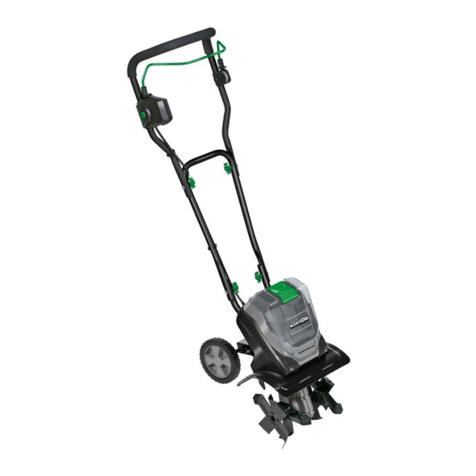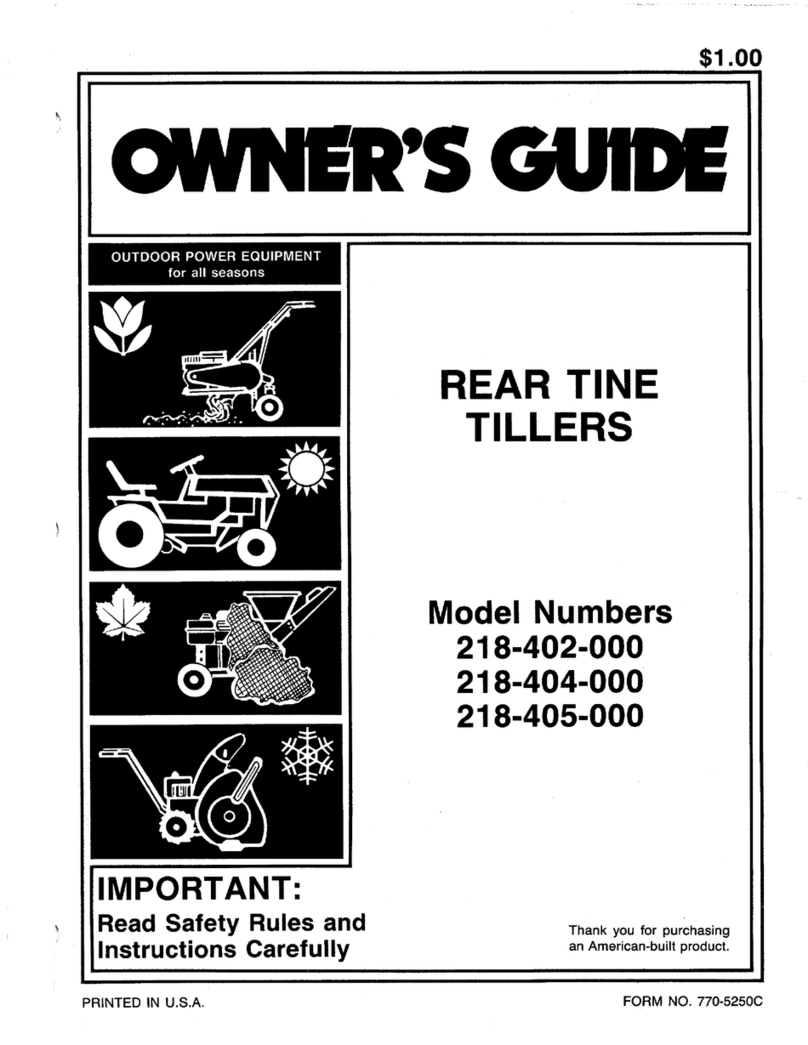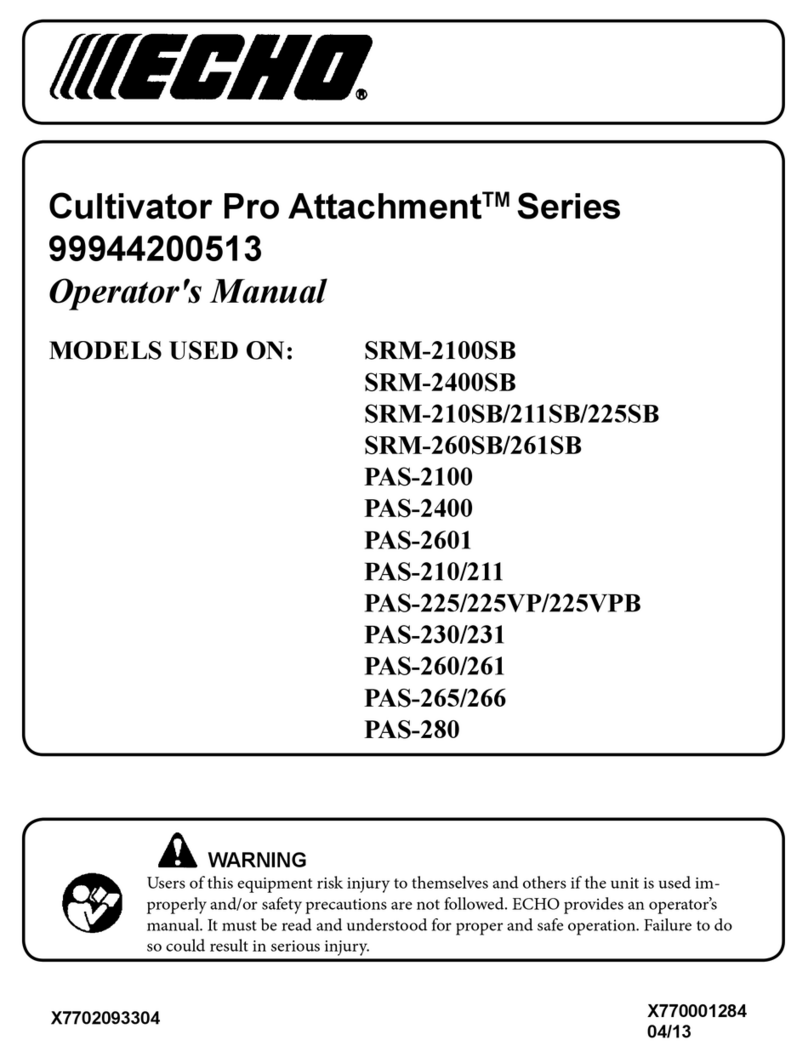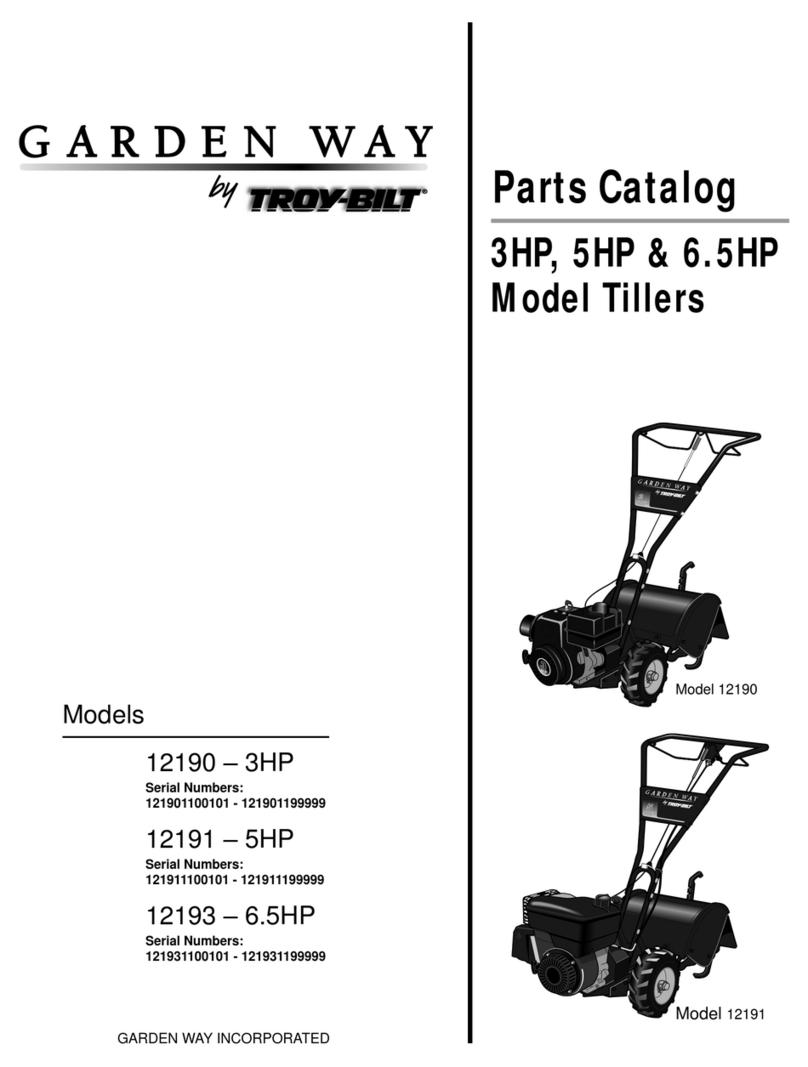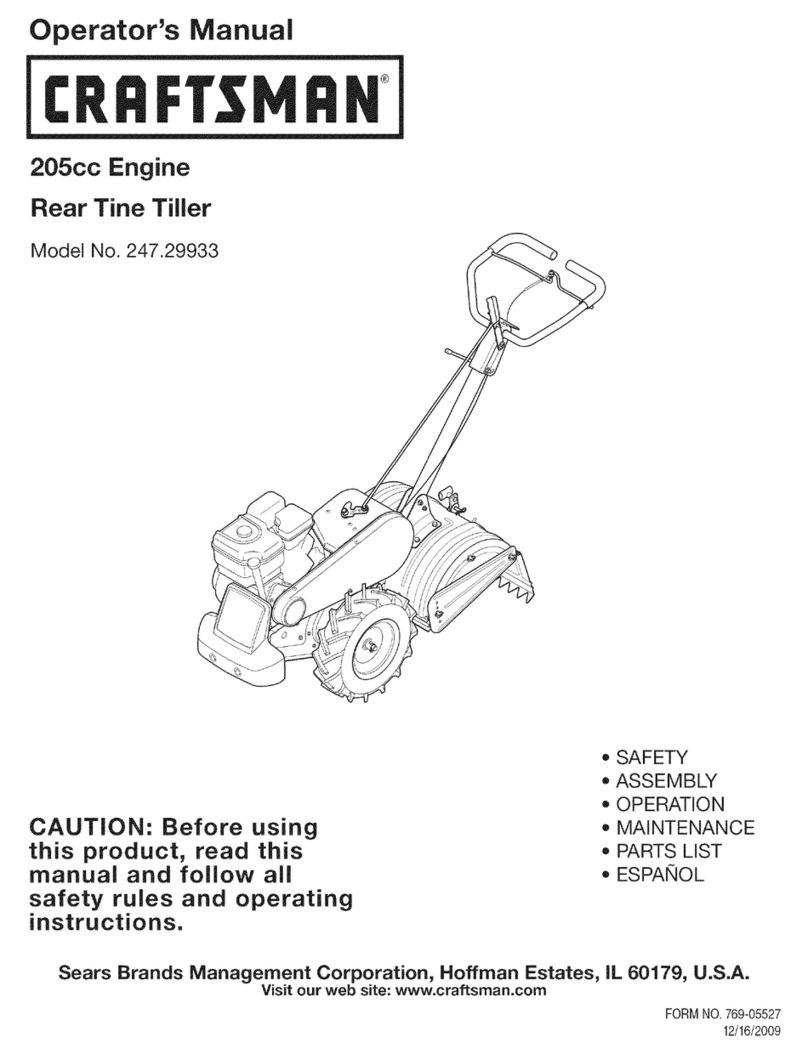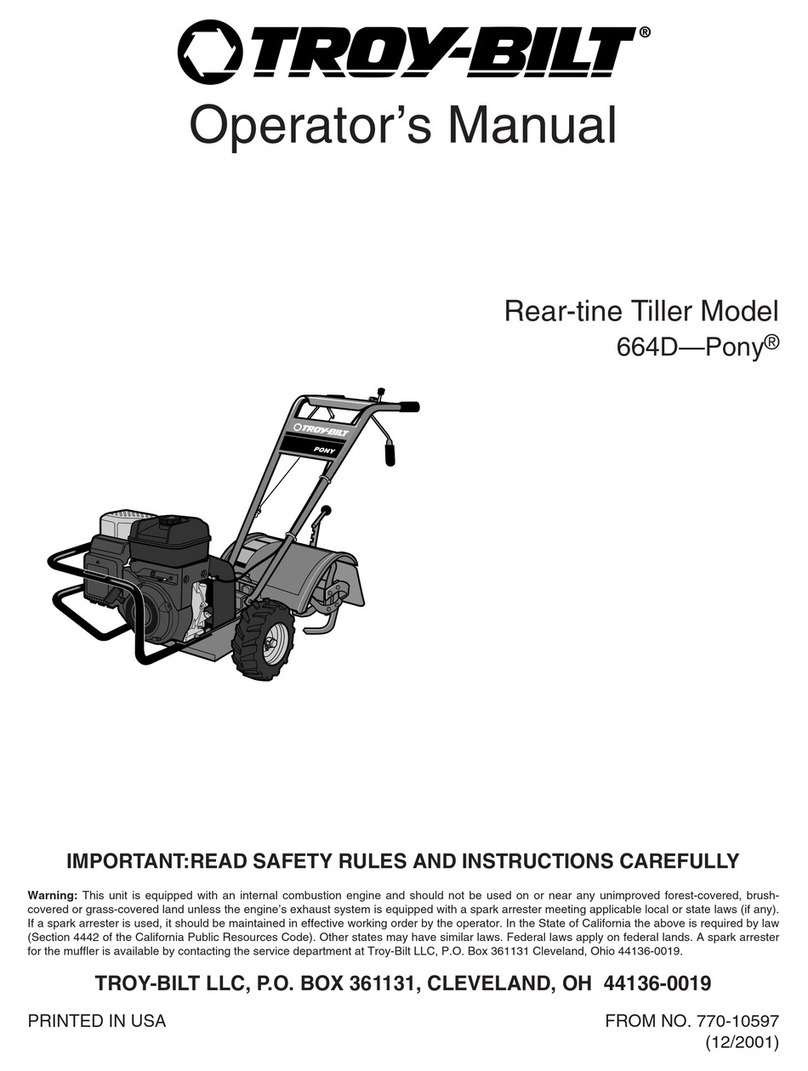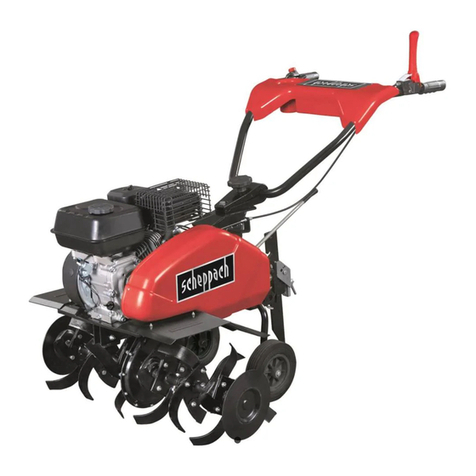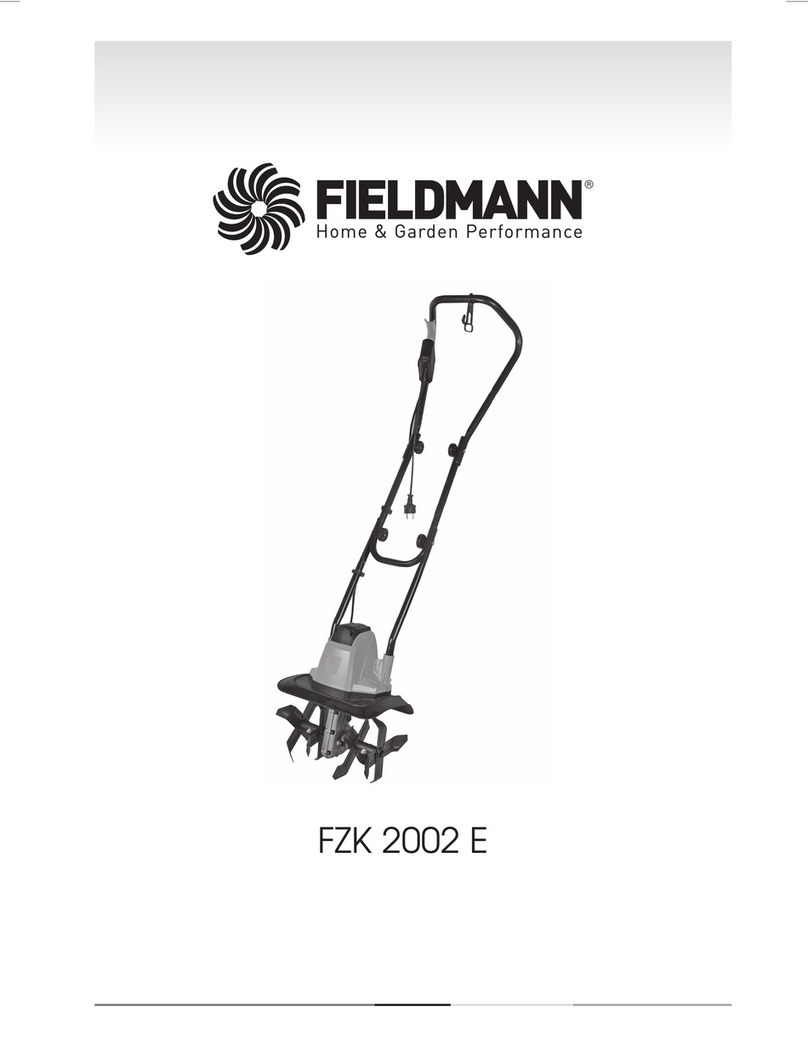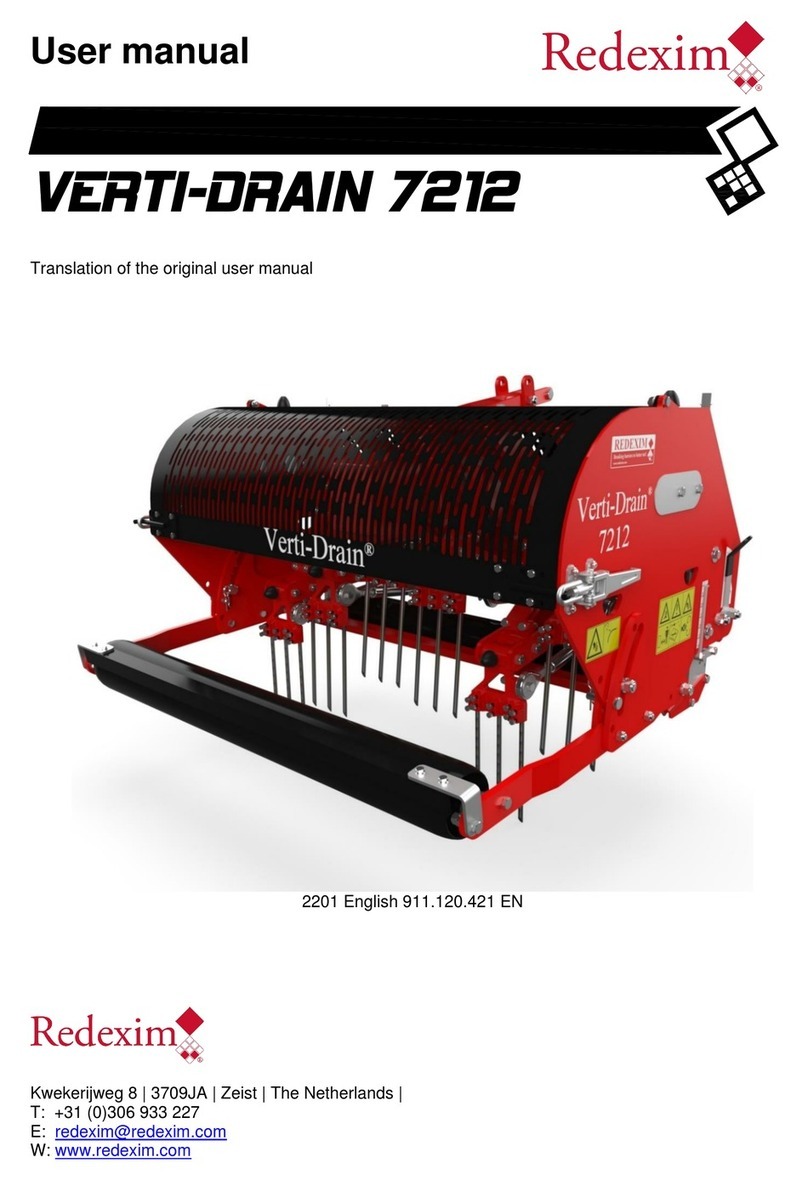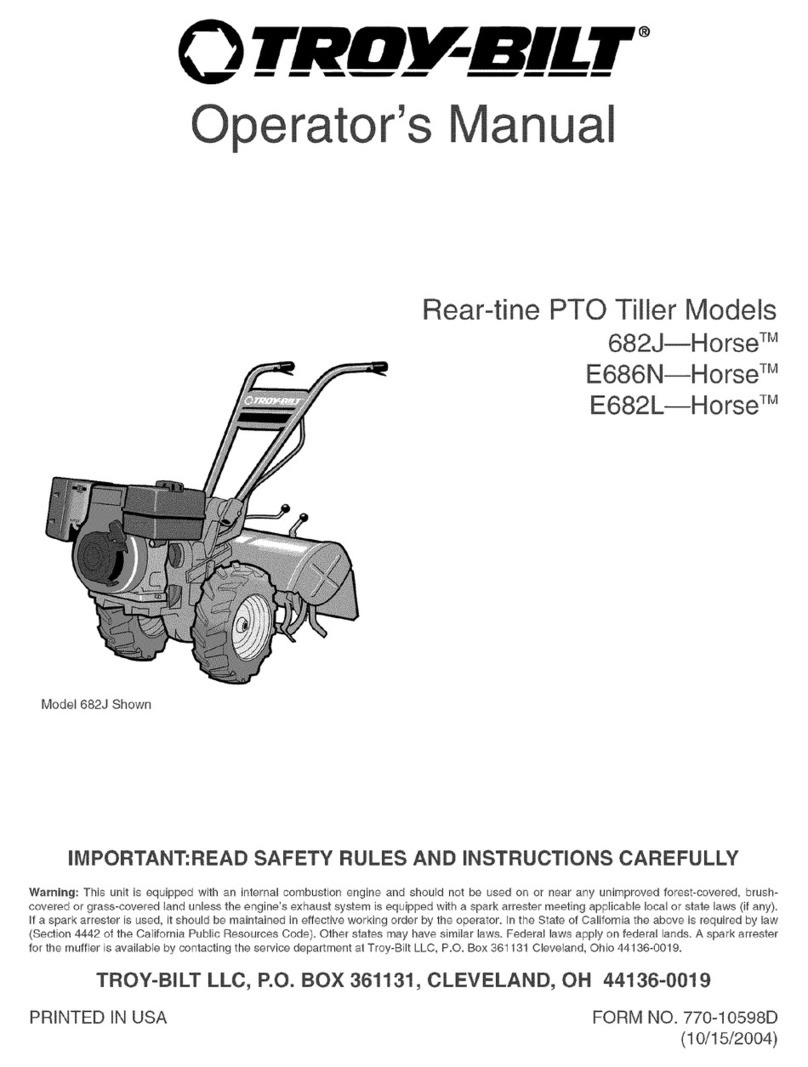Southern States SOR550 User manual

OPERATOR'SMANUAL
MODEL NO.SOR550 (96092000301)
5.5 HP 17 Inch
Tiller
For Parts and Service, contact our authorized distributor: call 1-800-849-1297
For Technical Assistance: call 1-800-829-5886
SOUTHERN STATES
197284 01.18.05 TR
PRINTED IN U.S.A.

SAFETY RULES
SAFE OPERATION PRACTICES FOR WALK-BEHIND POWERED ROTARYTILLERS
TRAINING
• Read the Owner's Manual carefully. Be thoroughly
familiar with the controls and the proper use of the
equipment. Know how to stop the unit and disengage
the controls quickly.
• Never allow children to operate the equipment. Never
allow adults to operate the equipment without proper
instruction.
• Keep the area of operation clear of all persons, par-
ticularly small children, and pets.
PREPARATION
• Thoroughly inspect the area where the equipment is
to be used and remove all foreign objects.
• Disengage all clutches and shift into neutral before
starting the engine (motor).
• Do not operate the equipment without wearing ade-
quate outer garments. Wear footwear that will improve
footing on slippery surfaces.
• Handle fuel with care; it is highly flammable.
• Use an approved fuel container.
• Never add fuel to a running engine or hot engine.
• Fill fuel tank outdoors with extreme care. Never fill fuel
tank indoors.
• Replace gasoline cap securely and clean up spilled
fuel before restarting.
• Use extension cords and receptacles as specified by
the manufacturer for all units with electric drive motors
or electric starting motors.
• Never attempt to make any adjustments while the
engine (motor) is running (except where specifically
recommended by manufacturer).
OPERATION
• Do not put hands or feet near or under rotating parts.
• Exercise extreme caution when operating on or cross-
ing gravel drives, walks, or roads. Stay alert for hidden
hazards or traffic. Do not carry passengers.
• After striking a foreign object, stop the engine (motor),
remove the wire from the spark plug, thoroughlyinspect
the tiller for any damage, and repair the damage before
restarting and operating the tiller.
• Exercise caution to avoid slipping or falling.
• If the unit should start to vibrate abnormally, stop the
engine (motor) and check immediately for the cause.
Vibration is generally a warning of trouble.
• Stop the engine (motor) when leaving the operating
position.
• Take all possible precautions when leaving the machine
unattended. Disengage the tines, shift into neutral, and
stop the engine.
• Before cleaning, repairing, or inspecting, shut off the
engine and make certain all moving parts have stopped.
Disconnect the spark plug wire, and keepthe wire away
from the plug to prevent accidental starting. Disconnect
the cord on electric motors.
• Do not run the engine indoors; exhaust fumes are
dangerous.
• Never operate the tiller without proper guards, plates,
or other safety protective devices in place.
• Keep children and pets away.
• Do not overload the machine capacity by attempting
to till too deep at too fast a rate.
• Never operate the machine at high speeds on slippery
surfaces. Look behind and use care when backing.
• Never allow bystanders near the unit.
• Use only attachments and accessories approved by
the manufacturer of the tiller.
• Never operate the tiller without good visibility or light.
• Be careful when tilling in hard ground. The tines may
catch in the ground and propel the tiller forward. If this
occurs, let go of the handlebars and do not restrain the
machine.
MAINTENANCE AND STORAGE
• Keep machine, attachments, and accessories in safe
working condition.
• Check shear pins, engine mounting bolts, and other
bolts at frequent intervals for proper tightness to be
sure the equipment is in safe working condition.
• Never store the machine with fuel in the fuel tank inside
a building where ignition sources are present, such
as hot water and space heaters, clothes dryers, and
the like. Allow the engine to cool before storing in any
enclosure.
• Always refer to the operator's guide instructions for
important details if the tiller is to be stored for an ex-
tended period.
- IMPORTANT-
CAUTIONS, IMPORTANTS,AND NOTES ARE A MEANS OF
ATTRACTING ATTENTION TO IMPORTANT OR CRITICAL
INFORMATION INTHIS MANUAL.
IMPORTANT: USED TO ALERT YOU THAT THERE IS A
POSSIBILITY OF DAMAGING THIS EQUIPMENT.
NOTE: Gives essential information that will aid you to
better understand, incorporate, or execute a particular set
of instructions.
Look for this symbol to point out im-
portant safety precautions. It means
CAUTION!!! BECOME ALERT!!! YOUR
SAFETY IS INVOLVED.
&CAUTION: Always disconnect spark
plug wire and place wire where it can-
not contact spark plug in order to pre-
vent accidental starting when setting
up, transporting, adjusting or making
repairs.
WARNING
The engine exhaust from this product contains
chemicals known to the State of California to
cause cancer, birth defects, or other reproduc-
tive harm.

PRODUCT SPECIFICATIONS
Gasoline Capacity: 3 Quarts (2.8L)
Unleaded Regular
Oil (API-SG-SL): SAE 30 (Above 32°F/0°C)
(Capacity: 20 oz./0.6L) SAE 5w-30 (Below 32°F/0°C)
Spark Plug : Champion
(Gap: .030"/0.76mm) RC12YC
CONGRATULATIONS on your purchase of a new tiller. It
has been designed, engineered and manufactured to give
you the best possible dependability and performance.
Should you experience any problems you cannot easily
remedy, please contact your nearest authoriFed service
center. We have competent, well-trained technicians and
the proper tools to service or repair this unit.
Please read and retain this manual. The instructions will
enable you to assemble and maintain your tiller properly.
Always observe the "SAFETY RULES".
CUSTOMER RESPONSIBILITIES
• Read and observe the safety rules.
• Follow a regular schedule in maintaining, caring for
and using your tiller.
• Follow instructions under"Maintenance" and "Storage"
sections of this Operator's Manual.
WARNING:This unit isequipped with an internal combustion
engine and should not be used on or near any unimproved
forest-covered, brush-covered or grass covered land un-
less the engine's exhaust system is equipped with a spark
arrester meeting applicable local or state laws (if any). If a
spark arrester is used, it should be maintained in effective
working order by the operator.
In the state of California the above is required by law (Sec-
tion 4442 of the California Public Resources Code). Other
states may have similar laws. Federal laws apply on federal
lands. SeeyourAuthoriFed Service Center/Department for
spark arrester. Refer to the Repair Parts section of this
manual for part number.
TABLE OF CONTENTS
SAFETY RULES ............................................................ 2
CUSTOMER RESPONSIBILITIES ................................. 3
PRODUCT SPECIFICATIONS ....................................... 3
ASSEMBLY ................................................................. 4-6
OPERATION ............................................................. 7-11
MAINTENANCE SCHEDULE ...................................... 12
MAINTENANCE ..................................................... 12-14
SERVICE & ADJUSTMENTS ................................. 15-18
STORAGE .................................................................... 19
TROUBLESHOOTING ................................................. 20
WARRANTY ................................................................. 22
3

ASSEMBLY
Your new tiller has been assembled at the factory with exception of those parts left unassembled for shipping purposes.
To ensure safe and proper operation of your tiller, all parts and hardware you assemble must be tightened securely. Use
the correct tools as necessary to insure proper tightness.
TOOLS REQUIRED FOR ASSEMBLY
A socket wrench set will make assembly easier. Standard
wrench sizes are listed.
(1) Utility knife
(1) Tire pressure gauge
(1) Pair of pliers
(1) 9/16" wrench
OPERATOR'S POSITION (See Fig. 1)
When right or left hand is mentioned in this manual, it
means when you are in the operating position (standing
behind tiller handles).
LEFT
FRONT
OPERATOR'S
POSITION
RIGHT
FIG. 1
CONTENTS OF HARDWARE PACK
I/Y
(2) Handle Lock
(1) Flat Washer 13/32 x 1 x 11 Ga.
(1) Hairpin Clip
(1) Carriage Bolt
3/8-16 UNC x 1 Gr. 5
(1) Cable Clip
(1) Pivot Bolt
3/8-16 UNC Grade 5
©
@
(1) Center Locknut
3/8-16 UNC
(1) Handle Lock Lever
(2) Shear Pins & Clips
4

ASSEMBLY
UNPACKING CARTON (See Fig. 2)
I_hl CAUTION: Becareful ofexposed staples
when handling or disposing of carton-
ing material.
IMPORTANT: WHEN UNPACKING AND ASSEMBLING
TILLER, BE CAREFUL NOTTO STRETCH OR KINK CABLES.
• While holding handle assembly, cut cable ties securing
handle assembly to top frame. Let handle assembly
rest on tiller.
• Remove top frame of carton.
• Slowly ease handle assembly up and place on top of
carton.
• Cut down right hand front and right hand rear corners
of carton, lay side carton wall down.
• Remove packing material from handle assembly.
• Separate shift rod from handle assembly.
SHIFT ROD
EMBLY
FIG. 2
INSTALL HANDLE (See Figs. 3, 4, and 5)
• Insert one handle lock (with teeth facing outward) in
gearcase notch. (Apply grease on smooth side of
handle lock to aid in keeping lock in place until handle
assembly is lowered into position.)
VIEWED FROM R.H. SIDE OF TILLER
\X HANDLE AS-
_ SEMBLY GEARCASE
_NOTCH
"_'_ /HANDLE
FIG. 3
Grasp handle assembly. Hold in "up" position. Be sure
handle lock remains in gearcase notch. Slide handle
assembly into position.
HANDLE ASSEMBLY
"UP" POSITION
TIGHTEN HANDLE
LOCK LEVER TO
HOLD
LOOSEN HANDLE
LOCK LEVER TO
MOVE
FIG. 4
• Rotate handle assembly down. Insert rear carriage bolt
first, with head of bolt on L.H. side of tiller and loosely
assemble Iocknut (See Fig. 5).
• Insert pivot bolt in front part of plate and tighten.
• Cut down remaining corners of carton and lay panels
flat.
• Lower the handle assembly. Tighten nut on carriage
bolt so handle moves with some resistance. This will
allow for easier adjustment.
• Place flat washer on threaded end of handle lock le-
ver.
• Insert handle lock lever through handle base and
gearcase. Screw in handle lock lever just enough to
hold lever in place.
• Insert second handle lock (with teeth inward) in the
slot of the handle base (just inside of washer).
• Raise handle assemblyto highest position and securely
tighten handle lock lever by rotating clockwise. Leaving
handle assembly in highest position will make it easier
to connect shift rod.
REAR
CARRIAGE
BOLT
HANDLE
GEARCASE LOCK FLAT
\WASHER
SLOT_
HANDLE
LOCK
LEVER
HANDLE
BASE
LOCKNUTS _PIVOT BOLT
FIG. 5
5

ASSEMBLY
INSERT CABLE CLIP (See Fig. 6)
• Insert plastic cable clip into hole on the back of handle
column. Push cables into clip.
HANDLE
COLUMN X
;ABLE CLIP
FIG. 6
CONNECT SHIFT ROD (See Fig. 7)
• Insert end of shift rod farthest from bend into hole of
shift lever indicator.
• Insert hairpin clip through hole of shift rod to secure
with bend of clip on right side.
REMOVE TILLER FROM CRATE
• Adjust handle assemby to lowest position. Be sure lock
lever is tightened securely.
• Make sure shift lever indicator is in"N" (neutral) position
(See Fig. 7)
• Tilt tiller forward by lifting handle. Separate cardboard
cover from leveling shield.
• Rotate tiller handle to the right and pull tiller out of
carton.
CHECKTIRE PRESSURE
The tires on your unit were overinflated at the factory for
shipping purposes. Correct and equal tire pressure is
important for best tilling performance.
• Reduce tire pressure to 20 PSI.
HANDLE HEIGHT
• Handle height may be adjusted to better suit operator.
(See "TO ADJUST HANDLE HEIGHT" in the Service
and Adjustments section of this manual).
ATTACH THIS END TO SHIFT
LEVER INDICATOR\
SHIFT ROD /
SHIFT
SHIFT
HAIRPIN LEVER
CLIF INDICATO
FIG. 7
6

OPERATION
KNOW YOUR TILLER
READ THIS OWNER'S MANUAL AND SAFETY RULES BEFORE OPERATING YOUR TILLER.
Compare the illustrations with your tiller to familiarize yourself with the location of various controls and adjustments. Save
this manual for future reference.
These symbols may appear on your Tiller or in literature supplied with the product. Learn and understand their
meaning.
F N R& -= I\l
[LUNG FORWARD NEUTRAL REVERSE CAUTION ENGINE ENGINE FAST SLOW CHOKE
OR WARNING ON OFF
DRIVE CONTROL
BAR
tHROTTLE CONTROL
SHIFT LEVER
INDICATOR
CHOKE CONTROL
DEPTH STAKE
LEVELING
SHIELD
OUTER SIDE
SHIELD
RECOIL
STARTER
HANDLE
FIG. 8
MEETS ANSI SAFETY REQUIREMENTS
Our tillers conform to the safety standards of the American National Standards Institute.
CHOKE CONTROL - Used when starting a cold engine.
DEPTH STAKE - Controls depth at which tiller will dig.
DRIVE CONTROL BAR - Used to engage tiller.
LEVELING SHIELD - Levels tilled soil.
OUTER SIDE SHIELD - Adjustable to protect small plants
from being buried.
RECOIL STARTER HANDLE - Used to start the engine.
SHIFT LEVER - Used to shift transmission gears.
SHIFT LEVER INDICATOR - Shows which gear the trans-
....
mÁssÁÙnISIn.
THROTTLE CONTROL - Used to control engine speed.
7

OPERATION
SAFETYGLASSES The operation of any tiller can result in foreign objects thrown into the eyes, which can
result in severe eye damage. Always wear safety glasses or eye shields before starting
your tiller and while tilling. We recommend a wide vision safety mask over spectacles or
standard safety glasses.
HOW TO USE YOUR TILLER
Know how to operate all controls before adding fuel and
oil or attempting to start engine.
STOPPING (See Fig. 9)
TINES AND DRIVE
• Release drive control bar to stop movement.
• Move shift lever to "N" (neutral) position.
ENGINE
• Move throttle control to "STOP" position. If equipped
with stop switch, move switch to "STOP" position.
• Never use choke to stop engine.
DRIVE CONTROL BAR
"ENGAGED" POSITION THROTTLE
CONTROL
SHIFT
LEVER
DRIVE CONTROL BAR
"DISENGAGED'POSITION
FIG. 9
TINE OPERATION - WITH WHEEL DRIVE
• Always release drive control bar before moving shift
lever into another position.
• Tine movement is achieved by moving shift lever to
(_) till position and engaging drive control bar.
FORWARD- WHEELS ONLY/TINES
STOPPED
• Release drive control bar and move shift lever indicator
to "F" (forward) position. Engage drive control bar and
tiller will move forward.
REVERSE -WHEELS ONLY/TINES STOPPED
• DO NOT STAND DIRECTLY BEHIND TILLER.
• Release the drive control bar.
• Move throttle control to "SLOW" position.
• Move shift lever indicator to "R" (reverse) position.
• Hold drive control bar against the handle to start tiller
movement.
HARD TO SHIFT GEARS
• Briefly engage drive control barand release or rocktiller
forward and backward until are able to shift gears.
DEPTH STAKE (See Fig. 10)
The depth stake can be raised or lowered to allow you more
versatile tilling and cultivating, or to more easily transport
!our tiller.
SHALLOWEST
TILLING
(CULTIVATING_
DEEPEST
TILLING
DEPTH _
STAKE
FIG. 10
TRANSPORT
POSITION
TILLING (See Fig. 11)
• Release depth stake pin. Pull the depth stake up for
increased tilling depth. Place depth stake pin in hole
of depth stake to lock in position.
• Place shift lever indicator in till position.
• Hold the drive control bar against the handle to start
tilling movement. Tines and wheels will both turn.
• Move throttle control to "FAST" position for deep tilling.
To cultivate, throttle control can be set at any desired
speed, depending on how fast or slow you wish to
cultivate.
IMPORTANT: ALWAYS RELEASE DRIVE CONTROL
BAR BEFORE MOVING SHIFT LEVER INTO ANOTHER
POSITION.
DEPTH STAKE PIN
"RELEASED" POSITION
\
NUT "B"
OUTER
SIDE SHIELD NUT"A" S
FIG. 11
"LOCKED"
POSITION
8

OPERATION
TURNING
• Release the drive control bar.
• Move throttle control to "SLOW" position.
• Place shift lever indicator in"F' (forward) position. Tines
will not turn.
• Lift handle to raise tines out of ground.
• Swing the handle in the opposite direction you wish
to turn, being careful to keep feet and legs away from
tines.
• When you have completed your turn-around, release
the drive control bar and lower handle. Place shift
lever in till position and move throttle control to desired
speed. To begin tilling, hold drive control bar against
the handle.
OUTER SIDE SHIELDS (See Fig. 11)
The back edges of the outer side shields are slotted so
that the shields can be raised for deep tilling and lowered
for shallow tilling to protect small plants from being buried.
Loosen nut "A" in slot and nut "B". Move shield to desired
position (both sides). Retighten nuts.
TO TRANSPORT
CAUTION: Before lifting or transporting,
allow tiller engine and muffler to cool.
Disconnect spark plug wire. Drain
gasoline from fuel tank.
AROUNDTHEYARD
• Release the depth stake pin. Move the depth stake
down to the top hole fortransporting the tiller. Place
depth stake pin in hole of depth stake to lock in posi-
tion. This prevents tines from scuffing the ground.
• Place shift lever indicator in "F" (forward) position for
transporting.
• Hold the drive control bar against the handle to start
tiller movement. Tines will not turn.
• Move throttle control to desired speed.
AROUND TOWN
• Disconnect spark plug wire.
• Drain fuel tank.
• Transport in upright position to prevent oil leakage.
BEFORE STARTING ENGINE
IMPORTANT: BE VERY CAREFUL NOT TO ALLOW DIRT
TO ENTER THE ENGINE WHEN CHECKING OR ADDING
OIL OR FUEL. USE CLEAN OIL AND FUEL AND STORE IN
APPROVED, CLEAN, COVERED CONTAINERS. USE CLEAN
FILL FUNNELS.
CHECK ENGINE OIL LEVEL (See Fig. 12)
• The engine in your unit has been shipped, from the
factory, already filled with SAE 30 summer weight oil.
• With engine level, clean area around oil filler plug and
remove plug.
• Engine oil should beto pointofoverflowing when engine
is level. For approximate capacity see "PRODUCT
SPECIFICATIONS" on page 3 of this manual. All oil
must meet A.EI. Service Classification SG-SL.
For cold weather operation you should change oil for
easier starting (See oil viscosity chart in the Mainte-
nance section of this manual).
To change engine oil, see the Maintenance section in
this manual.
OIL FILLER
PLUG
OIL DRAIN
PLUG
FIG. 12
ADD GASOLINE
• Fill fuel tank to bottom of filler neck. Do not overfill.
Use fresh, clean, regular unleaded gasoline with a
minimum of 87 octane. (Use of leaded gasoline will
increase carbon and lead oxide deposits and reduce
valve life). Do not mix oil with gasoline. Purchase fuel
in quantities that can be used within 30 days to assure
fuel freshness.
CAUTION: Fill to within 112inch of top
offuel tankto prevent spills and to allow
for fuel expansion. If gasoline is ac-
cidentally spilled, move machine away
from area of spill. Avoid creating any
source of ignition until gasoline vapors
have disappeared.
Wipe off any spilled oil or fuel. Do not
store, spill or use gasoline near an
open flame.
IMPORTANT: WHEN OPERATING IN TEMPERATURES
BELOW32°F(0°C), USE FRESH, CLEAN WINTER GRADE
GASOLINE TO HELP INSURE GOOD COLD WEATHER
STARTING.
CAUTION: Alcohol blended fuels (called
gasohol or using ethanol or methanol) can at-
tract moisture which leads to separation and
formation of acids during storage. Acidic gas
can damage the fuel system of an engine while
in storage. To avoid engine problems, the fuel
system should be emptied before storage of
30 days or longer. Drain the gas tank, start
the engine and let it run until the fuel lines
and carburetor are empty. Use fresh fuel next
season. See Storage Instructions for additional
information. Never use engine or carburetor
cleaner products in the fuel tank or permanent
damage may occur.
9

OPERATION
TO START ENGINE (See Fig. 13) TILLING HINTS
I&CAUTION: Keep drive control bar in I
i
"DISENGAGED" position when start- I
ing engine.
When starting engine for the first time or if engine has run
out of fuel, it will take extra pulls of the recoil starter to
move fuel from the tank to the engine.
• Make sure spark plug wire is properly connected.
• Move shift lever indicator to "N" (neutral) position.
• Place throttle control in "FAST" position.
• Turn fuel shut-off valve 1/4 turn to open position.
• Move choke control to choke position.
• Grasp recoil starter handle with one hand and grasp
tiller handle with other hand. Pull rope out slowly until
engine reaches start of compression cycle (rope will
pull slightly harder at this point).
• Pull recoil starter handle quickly. Do not let starter
handle snap back against starter.
• If engine fires but does not start, move choke control
to half choke position. Pull recoil starter handle until
engine starts.
• When engine starts, slowly move choke control to
"RUN" position as engine warms up.
NOTE: A warm engine requires less choking to start.
• Move throttle control to desired running position.
• Allow engine to warm up for a few minutes before
engaging tines.
NOTE: If at a high altitude (3000 feet) or in cold
temperatures (below 32°F), the carburetor fuel mixture
may need to be adjusted for best engine performance.
See "TO ADJUST CARBURETOR" in the Service and
Adjustments section of this manual.
NOTE: If engine does not start, see troubleshooting
points.
CHOKE CONTROL
RECOIL STARTER HANDLE
FIG. 13
&CAUTION: Until you areaccustomedto
handling your tiller,start actual field use
with throttle in slow position (mid-way
between "FAST" and "IDLE").
• Tilling is digging into, turning over, and breaking up
packed soil before planting. Loose, unpacked soil helps
root growth. Best tilling depth is 4" to 6" (10-15 cm).
A tiller will also clear the soil of unwanted vegetation.
The decomposition of this vegetable matter enriches
the soil. Depending on the climate (rainfall and wind),
it may be advisable to till the soil at the end of the
growing season to further condition the soil.
• Soil conditions are important for proper tilling.Tines will
not readily penetrate dry, hard soilwhich may contribute
to excessive bounce and difficult handling of your tiller.
Hard soil should be moistened before tilling; however,
extremely wet soil will "ball-up" or clump during tilling.
Wait until the soil is less wet in order to achieve the
best results. When tilling in the fall, remove vines and
long grass to prevent them from wrapping around the
tine shaft and slowing your tilling operation.
• You will find tilling much easier if you leave a row un-
tilled between passes. Then go back between tilled
rows. (See Fig. 14) There are two reasons for doing
this. First, wide turns are much easier to negotiate than
about-faces. Second, the tiller won't be pulling itself,
and you, toward the row next to it.
• Do not lean on handle. This takes weight off the wheels
and reduces traction. To get through a really tough
section of sod or hard ground, apply upward pressure
on handle or lower the depth stake.
J
FIG. 14
10

OPERATION
TINE SHEAR PINS
The tine assemblies on your tiller are secured to the tine
shaft with shear pins (See "TINE REPLACEMENT" in the
Service and Adjustments section of this manual).
If the tiller is unusually overloaded or jammed, the shear
pins are designed to break before internal damage occurs
to the transmission.
• If shear pin(s) break, replace only with those shown in
the Repair Parts section of this manual.
CULTIVATING
Cultivating is destroying the weeds between rows to pre-
vent them from robbing nourishment and moisture from the
plants. At the same time, breaking up the upper layer of
soil crust will help retain moisture in the soil. Best digging
depth is 1" to 3" (2.5-7.5 cm). Lower the outer side shields
to protect small plants from being buried.
• Cultivate up and down the rows at a speed which will
allow tines to uproot weeds and leave the ground in
rough condition, promoting no further growth of weeds
and grass (See Fig. 15).
FIG. 15
ADJUST WHEELS FOR CULTIVATING (See
Figs. 16 and 17)
• Place blocks under right hand side of tiller and remove
hairpin clip and clevis pin from right hand wheel.
• Move wheel outward approximately 1 inch (2.5 cm)
until hole in inner wheel hub lines up with inner hole
in axle.
• Replace clevis pin and hairpin clip on inside of wheel
and remove blocks.
• Repeat preceding steps on left hand side.
NOTE: In extremely rough conditions and while cultivat-
ing, the wheels should be moved outward on the axle for
increased stability.
OUTERVIEW OFTIRE
CLEVIS
IN
"_F--'-tire 1_ ) _ _ " HAIRPIN
CLip
FIG. 16
INNER VIEW OFTIRE
C,L V,S
FIG. 17
11

MAINTENANCE
MAINTENANCE
SCHEDULE
FILL IN DATES
AS YOU COMPLETE
REGULAR SERVICE
Check Engine Oil Level
Change Engine Oil _1,2
Oil Pivot Points If
Inspect Spark Arrester /Muffler I_
Inspect Air Screen I_
Clean or Replace Air Cleaner Cartridge 1_2
Clean Engine Cylinder Fins If
Replace Spark Plug I_
RH Gear Case Grease Fitting (1oz.)
-_'_' "$7_q_/-_'_@/-_'_ SERVICE DATES
1 - Change more often when operating under a heavy load or in high ambient temperatures.
2 - Service more often when operating in dirty or dusty conditions.
GENERAL RECOMMENDATIONS
The warranty on this tiller does not cover items that have
been subjected to operator abuse or negligence. Toreceive
full value from the warranty, the operator must maintain tiller
as instructed in this manual.
Some adjustments will need to be made periodically to
properly maintain your tiller.
At least once a season, check to see if you should make
any of the adjustments described in the Service and Ad-
justments section of this manual.
• Once a year you should replace the spark plug, clean
or replace air filter, and check tines and belts for wear.
A new spark plug and clean air filter assure proper
air-fuel mixture and help your engine run better and
last longer.
BEFORE EACH USE
• Check engine oil level.
• Check tine operation.
• Check for loose fasteners.
LUBRICATION
Keep unit well lubricated (See "LUBRICATION CHART").
LUBRICATION CHART
OTHROTTLE CONTROL
(_) ENGINE (_RH GEAR CASE
GREASE FITTING
STAKE PIN
LEVELING
SHIELD
HINGES
OIDLER
BRACKET OWHEEL HUB
OSAE 30 OR 10W-30 MOTOR OIL
(_REFER TO MAINTENANCE "ENGINE" SECTION
(_EP #1 GREASE
12

MAINTENANCE
Disconnect spark plug wire before performing any maintenance (except carburetor adjustment) to prevent
accidental starting of engine.
Prevent fires! Keep the engine free of grass, leaves, spilled oil, or fuel. Remove fuel from tank before tipping
unit for maintenance. Clean muffler area of all grass, dirt, and debris.
Do not touch hot muffler or cylinder fins as contact may cause burns.
ENGINE
LUBRICATION
Use only high quality detergent oil rated with API service
classification SG-SL. Select the oil's SAE viscosity grade
according to your expected temperature.
SAE VISCOSITY GRADES
4
F -20 0 30 32 40 60 80 100
c-_0 -2; -1; lo _0 10 4;
TEMPERATURE RANGE ANTICIPATED BEFORE NEXT OIL CHANGE
oilviscchar tI e
FIG. 18
NOTE: Although multi-viscosityoils (5W-30, 10W-30, etc.)
improve starting in cold weather, these multi-viscosity oils
will result in increased oil consumption when used above
32°F (0°C). Check your engine oil level more frequently to
avoid possible engine damage from running low on oil.
Change the oil after every 25 hours of operation or at
least once a year if the tiller is not used for 25 hours in
one year.
Check the crankcase oil level before starting the engine
and after each five (5) hours of continuous use. Add SAE
30 motor oil or equivalent. Tighten oil filler plug securely
each time you check the oil level.
TO CHANGE ENGINE OIL (See Figs. 18 and 19)
Determine temperature range expected before oil change.
All oil must meet API service classification SG-SL.
• Be sure tiller is on level surface.
• Oil will drain more freely when warm.
• Use a funnel to prevent oil spill on tiller, and catch oil
in a suitable container.
• Remove drain plug.
• Tip tiller forward to drain oil.
• After oil has drained completely, replace oil drain plug
and tighten securely.
• Remove oil filler plug. Be careful not to allow dirt to
enter the engine.
• Refill engine with oil. See"CHECK ENGINE OIL LEVEl"
in the Operation section of this manual.
O,L
DRAIN ._
PLUG C!
_.% \ "OIL LEVEL
OIL FILLER
_j PLUG
FIG. 19
AIR FILTER (See Fig. 20)
Your engine will not run properly using a dirty airfilter. Clean
the foam pre-cleaner after every 25 hours of operation or
every season. Service paper cartridge every 100 hours of
operation or every season, whichever occurs first.
Service air cleaner more often under dusty conditions.
• Remove cover screw and cover.
TO SERVICE PRE-CLEANER
• Remove foam pre-cleaner from air cleaner cover.
• Wash it in liquid detergent and water.
• Squeeze it dry in a clean cloth.
• If very dirty or damaged, replace pre-cleaner.
• Reinstall pre-cleaner into air cleaner cover.
• Reinstall cover and secure screw.
TO SERVICE CARTRIDGE
• Carefully remove cartridge to prevent debris from
entering carburetor. Clean base carefully to prevent
debris from entering carburetor.
• Clean cartridge by tapping gently on flat surface. If
very dirty or damaged, replace cartridge.
• Reinstall cartridge, cover with pre-cleaner and secure
with screw.
IMPORTANT:PETROLEUMSOLVENTS,SUCHAS KEROSENE,
ARE NOT TO BE USED TO CLEAN THE CARTRIDGE. THEY
MAYCAUSE DETERIORATIONOFTHECARTRIDGE. DONOT
OILCARTRIDGE.DONOTUSEPRESSURIZEDAIRTO CLEAN
OR DRY CARTRIDGE.
COVER
KNOB
FIG. 20
COOLING SYSTEM (See Fig. 21)
Your engine is air cooled. For proper engine performance
and long life keep your engine clean.
• Clean air screen frequently using a stiff-bristled
brush.
• Remove blower housing and clean as necessary.
• Keep cylinder fins free of dirt and chaff.
13

MAINTENANCE
CYLINDER FINS
MUFFLER
HOUSING
SCREEN
FIG. 21
MUFFLER
Do not operate tiller without muffler. Do not tamper with
exhaust system. Damaged muftiers or spark arresters could
create a fire hazard. Inspect periodically and replace if
necessary. If your engine is equipped with a spark arrester
screen assembly, remove every 50 hours for cleaning and
inspection. Replace if damaged.
SPARK PLUG
Replace spark plugs at the beginning of each tilling sea-
son or after every 50 hours of use, whichever comes first.
Spark plug type and gap setting is shown in "PRODUCT
SPECIFICATIONS" on page 3 of this manual.
TRANSMISSION
Once a season, lubricate the right hand side gear case
grease fitting with oz. of EP #1 grease.
CLEANING
Do not clean your tiller when the engine and transmission
are hot. We do not recommend using pressurized water
(garden hose, etc.) to clean your unit unless the gasket
area around the transmission and the engine muffler, air
filter and carburetor are covered to keep water out. Water
in engine will shorten the useful life of your tiller.
• Clean engine, wheels, finish, etc. of all foreign mat-
ter.
• Keep finished surfaces and wheels free of all gasoline,
oil, etc.
• Protect painted surfaces with automotive type wax.
14

SERVICE AND ADJUSTMENTS
!
CAUTION: Disconnect spark plug wire from spark plug and place wire where it cannot come into I
contact with plug. I
TO ADJUST HANDLE HEIGHT (See Fig. 22)
Select handle height best suited for your tilling conditions.
Handle height will be different when tiller digs into soil.
• First loosen handle lock lever.
• Handle can be positioned at different settings between
"HIGH" and "LOW" positions.
• Retighten handle lock lever securely after adjusting.
TIRE CARE
I& CAUTION: When mounting tires, un- I
less beads are seated, overinflation can
cause an explosion.
• Maintain 20 PSI (1.4 kg/cm 2) of tire pressure. If tire
pressures are not equal, tiller will pull to one side.
• Keep tires free of gasoline or oil which can damage
rubber.
(HIGH POSITION)
HANDLE LOCK
LEVER
HANDLE (LOW
POSITION)
FIG. 22
TO REMOVE WHEEL (See Fig. 23)
• Place blocks under transmission to keep tiller from
tipping.
• Remove hairpin clip and clevis pin from wheel.
• Remove wheel and tire.
• Repair tire and reassemble.
CLEVIS PIN
HAIRPIN CLIP
FIG. 23
15

SERVICE AND ADJUSTMENTS
TINE REPLACEMENT
(See Figs. 24, 25 and 26)
I_ CAUTION: Tines are sharp. Wear I
gloves or other protection when han-
dling tines.
A badly worn tine causes your tiller to work harder and dig
more shallow. Most important, worn tines cannot chop and
shred organic matter as effectively nor bury it as deeply as
good tines. A tine this worn needs to be replaced.
NEW TINE WORN TINE
FIG. 24
To maintain the superb tilling performance of this
machine the tines should be checked for sharpness,
wear, and bending, particularly the tines which are
next to the transmission. If the gap between the tines
exceeds 3-1/2 inches (9 cm), they should be replaced
or straightened as necessary.
New tines should be assembled as shown in Fig.
28. Sharpened tine edges will rotate rearward from
above.
TINE
3-1/2" MAX (9 CM)----------------_', ,_---
TINE
FIG. 25
COUNTER
TINE
ROTATION
SHARP EDGE
HAIRPIN CLIP
SHARPEDGE
SHEAR
SHARP E_ 13
FIG. 26
16

SERVICE AND ADJUSTMENTS
TO REMOVE BELT GUARD
(See Fig. 27)
NOTE: For ease of removal, remove hairpin clip and clevis
pin from left wheel. Pull wheel out from tiller about 1 inch
(2.5 cm).
• Remove two (2) screws from side of belt guard.
• Remove hex nut and washer from bottom of belt guard
(located behind wheel).
• Pull belt guard out and away from unit.
• Replace belt guard by reversing above procedure.
BEN GUARD SCREW
HEX NUT
AND WASHER
(LOCATED BEHIND
TIRE)
SCREW HAIRPIN CLIP AND
CLEVIS PIN
FIG. 27
TO REPLACE GROUND DRIVE BELT
(See Figs. 27 and 28)
• Remove belt guard as described in"TO REMOVE BELT
GUARD".
• Remove old belt by slipping off engine pulley first then
remove from transmission pulley.
• Place new belt in groove of transmission pulley and
into engine pulley. BELT MUST BE IN GROOVE ON
TOP OF IDLER PULLEY. NOTE POSITION OF BELT
TO GUIDES.
• Check belt adjustment as described below.
• Replace belt guard.
• Reposition wheel and replace clevis pin and hairpin
clip.
GROUND DRIVE BELT ADJUSTMENT
(See Fig. 28)
For proper belt tension, the extension spring should have
about 5/8 inch (16 mm) stretch when drive control bar is
in "ENGAGED" position. This tension can be attained as
follows:
• Loosen cable clip screw securing the drive control
cable.
• Slide cable forward for less tension and rearward for
more tension until about 5/8 inch (16 mm) stretch is
obtained while the drive control bar is engaged.
• Tighten cable clip screw securely.
ENGINE
PULLEY SCREW
DRIVE
CONTROL
CABLE
IDLER
PULLEY
TRANSMISSION
PULLEY
FIG. 28
EXTENSION
SPRING
17

SERVICE AND ADJUSTMENTS
ENGINE TO ADJUST CARBURETOR
TO ADJUST THROTTLE CONTROL CABLE
(See Fig. 29)
The throttle control has been preset at the factory and
adjustment should not be necessary. If adjustment is
necessary, proceed as follows:
• With engine not running, move remote throttle control
lever to "FAST" position.
• If throttle lever on engine touches high speed stop, no
further adjustment is necessary. If throttle lever does
not touch high speed stop, continue with adjustment
procedure.
• Loosen cable clamp screw.
• Move throttle lever up until it touches high speed stop,
and hold in this position.
• Tighten cable clamp screw securely.
FUEL // CLAMP
/SCREW I/CASING
I/ ANDWlRE
_ROTTLE
CONTROL
The carburetor has been preset at the factoryand adjustment
should not be necessary. However, engine performance
can be affected by differences in fuel, temperature, altitude
or load. If the carburetor does need adjustment, contact
your nearest authorized service center/department
IMPORTANT: NEVERTAMPERWlTHTHE ENGINEGOVERNOR,
WHICH IS FACTORY SET FOR PROPER ENGINE SPEED.
OVERSPEEDING THE ENGINE ABOVE THE FACTORY HIGH
SPEED SETTING CAN BE DANGEROUS. IFYOU THINK THE
ENGINE-GOVERNED HIGH SPEED NEEDS ADJUSTING,
CONTACTYOU R NEARESTAUTHORIZED SERVICE CENTER/
DEPARTMENT, WHICH HAS THE PROPER EQUIPMENT AND
EXPERIENCE TO MAKE ANY NECESSARY ADJUSTMENTS.
FIG. 29
18

STORAGE
Immediately prepare your tiller for storage at the end of the
season or if the unit will not be used for 30 days or more.
AWARNING: Never store the tiller with
gasoline in the tank inside a building
where fumes may reach an open flame
or spark. Allow the engineto cool before
storing in any enclosure.
TILLER
• Clean entire tiller (See"CLEANING"in the Maintenance
section of this manual).
• Inspect and replace belts, if necessary (See belt re-
placement instructions in the Service and Adjustments
section of this manual).
• Lubricate as shown in the Maintenance section of this
manual.
• Be sure that all nuts, bolts and screws are securely
fastened. Inspect moving parts for damage, breakage
and wear. Replace if necessary.
• Touch up all rusted or chipped paint surfaces; sand
lightly before painting.
ENGINE
FUEL SYSTEM
IMPORTANT:ITISIMPORTANTTOPREVENTGUM DEPOSITS
FROMFORMINGIN ESSENTIALFUELSYSTEM PARTSSUCH
ASTHE CARBURETOR, FUELFILTER,FUELHOSE, ORTANK
DURING STORAGE. ALSO, EXPERIENCE INDICATES THAT
ALCOHOL BLENDED FUELS (CALLED GASOHOL OR USING
ETHANOLORMETHANOL)CANATTRACTMOISTUREWHICH
LEADSTOSEPARATIONAND FORMATIONOFACIDSDURING
STORAGE.ACIDIC GAS CAN DAMAGETHE FUEL SYSTEM
OF AN ENGINEWHILE IN STORAGE.
• Empty the fuel tank by starting the engine and let it run
until the fuel lines and carburetor are empty.
• Never use engine or carburetor cleaner products in the
fuel tank or permanent.
• Use fresh fuel next season.
NOTE: Fuel stablizer is an acceptable alternative in
minimizing the formation of fuel gum deposits during
storage. Add stabilizer to gasoline in fuel tank or storage
container. Always follow the mix ratio found on stablizer
container. Run engine at least 10 minutes after adding
stablizer to allow the stabilizer to reach the carburetor.
Do not empty the gas tank and carburetor if using fuel
stabilizer.
ENGINE OIL
Drain oil (with engine warm) and replace with clean oil. (See
"ENGINE" in the Maintenance section of this manual).
CYLINDER(S)
• Remove spark plug.
• Pour 1 ounce (29 ml) of oil through spark plug hole
into cylinder.
• Pull starter handle slowly several times to distribute
oil.
• Replace with new spark plug.
OTHER
• Do not store gasoline from one season to another.
• Replace your gasoline can if your can starts to rust.
Rust and/or dirt in your gasoline will cause problems.
• If possible, store your unit indoors and cover it to give
protection from dust and dirt.
• Cover your unit with a suitable protective cover that
does not retain moisture. Do not use plastic. Plastic
cannot breathe which allows condensation to form and
will cause your unit to rust.
IMPORTANT: NEVER COVER TILLER WHILE ENGINE AND
EXHAUSTAREAS ARE STILLWARM.
19

TROUBLESHOOTING POINTS
CAUSE CORRECTIONPROBLEM
Will not start
Hard tostart
Loss of power
Engine overheats
Excessive bounce/
difficult handling
Soil balls up or clumps
Engine runs but tiller
won't move
Engine runs but labors
when tilling
Tines will not rotate
Hard to shift into gear
Tiller shuts off when
drive control bar
engaged
1. Out of fuel.
2. Engine not "CHOKED" properly.
3. Engine flooded.
4. Dirty air cleaner.
5. Water in fuel.
6. Clogged fuel tank.
7. Loose spark plug wire.
8. Bad spark plug or improper gap.
9. Carburetor out of adjustment.
1. Throttle control not set properly.
2. Dirty air cleaner.
3. Bad spark plug or improper gap.
4. Stale or dirty fuel.
5. Loose spark plug wire.
6. Carburetor out of adjustment.
1. Engine is overloaded.
2. Dirty air cleaner.
3. Low oil level/dirty oil.
4. Faulty spark plug.
5. Oil in fuel.
6. Stale or dirty fuel.
7. Water in fuel.
8. Clogged fuel tank.
9. Spark plug wire loose.
10. Dirty engine air screen.
11. Dirty/clogged muffler.
12. Carburetor out of adjustment.
13. Poor compression.
1. Low oil level/dirty oil.
2. Dirty engine air screen.
3. Dirty engine.
4. Partially plugged muffler.
5. Improper carburetor adjustment.
1. Ground too dry and hard.
1. Ground too wet.
1. Drive control bar is not engaged.
2. V-belt not correctly adjusted.
3. V-belt is off pulley(s).
1. Tilling too deep.
2. Throttle control not properly adjusted.
3. Carburetor out of adjustment.
1. Shear pin(s) broken.
1. Gears not timed.
1. Shift lever set in between counter rotating till
position and forward rotating till position.
2. Tines jammed.
1. Fill fuel tank.
2. See "TO START ENGINE" in Operation section.
3. Wait several minutes before attempting to start.
4. Clean or replace air cleaner cartridge.
5. Empty fuel tank and carburetor, and refill tank with
fresh gasoline.
6. Remove fuel tank and clean.
7. Make sure spark plug wire is seated properly on
plug.
8. Replace spark plug or adjust gap.
9. Make necessary adjustments.
1. Place throttle control in "FAST" position.
2. Clean or replace air cleaner cartridge.
3. Replace spark plug or adjust gap.
4. Empty fuel tank and refill with fresh gasoline.
5. Make sure spark plug wire is seated properly on
plug.
6. Make necessary adjustments.
1. Set depth stake for shallower tilling.
2. Clean or replace air cleaner cartridge.
3. Check oil level/change oil.
4. Clean and regap or change spark plug.
5. Empty and clean fuel tank and refill, and clean
carburetor.
6. Empty fuel tank and refill with fresh gasoline.
7. Empty fuel tank and carburetor, and refill tank with
fresh gasoline.
8. Remove fuel tank and clean.
9. Connect and tighten spark plug wire.
10. Clean engine air screen.
11. Clean/replace muffler.
12. Make necessary adjustments.
13. Contact an authorized service center/department.
1. Check oil level/change oil.
2. Clean engine air screen.
3. Clean cylinder fins, air screen, and muffler area.
4. Remove and clean muffler.
5. Adjust carburetor to richer position.
1. Moisten ground or wait for more favorable soil
conditions.
1. Wait for more favorable soil conditions.
1. Engage drive control.
2. Inspect/adjust V-belt.
3. Inspect V-belt.
1. Set depth stake for shallower tilling.
2. Check throttle control setting.
3. Make necessary adjustments.
1. Replace shear pin(s).
1. Briefly engage drive control bar and release or rock
tiller forward and backward until are able to shift
gears.
1. Shift to either counter rotating till position or forward
rotating till position.
2. Clear tines.
20
Other manuals for SOR550
1
This manual suits for next models
1
Table of contents
Other Southern States Tiller manuals

Southern States
Southern States 96082000200 User manual

Southern States
Southern States SO620A User manual

Southern States
Southern States SOR550 User manual

Southern States
Southern States SOR900A User manual

Southern States
Southern States SOF550A User manual

Southern States
Southern States SOF555 User manual

Southern States
Southern States SOF555A User manual

Southern States
Southern States SOR500A User manual

Southern States
Southern States AGR550A User manual

Southern States
Southern States WAF550A User manual



